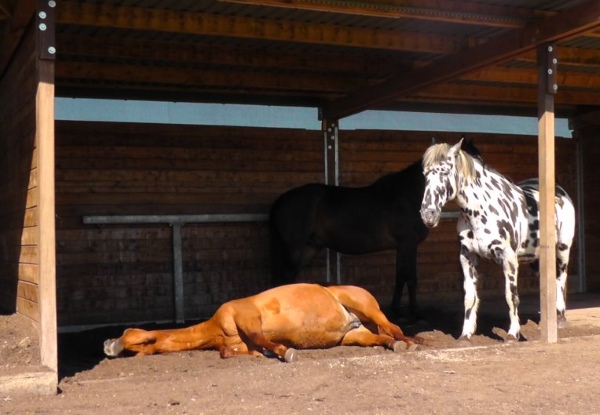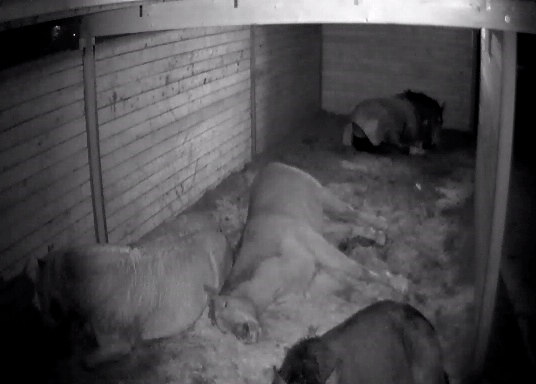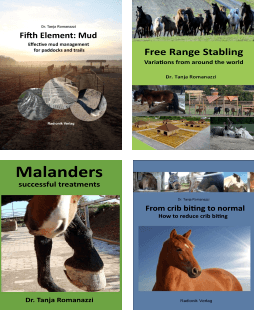Are there any better alternatives to a run-in shed?
In my own experience, and according to feedback I have received from other stable owners, many herds do not use their run-in sheds for lying down. What are the causes? What can you do about it? Do you need to do anything at all?

Horses are creatures of the steppe. They don’t build themselves caves there, instead, they spend the night outdoors. They generally choose places with an unimpeded view, allowing them to spot potential predators in time. In bad weather, they choose a sheltered location, in warm weather, they prefer airy spaces. The ground should be more or less dry, slip-proof and malleable. Apart from one or two watchers, the horses prefer to lie down together, maintaining spaces between each other, the size of which may vary depending on rank and friendship status.
Various reasons why horses may not use their run-in shed for lying down
The view is obstructed. There may be only two narrow exits or entrances, which may also be curtained off with strips of PVC. The horses don’t feel safe inside the shed.
Insufficient means of escape This may be the case, for example, if the shed is at the end of a narrow cul-de-sac or if the structure is deep rather than wide. The horses will not be able to leave quickly enough in case of danger, and this makes them uneasy.
Inadequate footing. Many horses like to use sheds strewn with bedding as a toilet. Which is why some stable owners opt for rubber mats with no bedding. Some horses will happily lie down on these, many others, however, won’t, especially if they are unfamiliar. Spreading a little sawdust on top to familiarise the horses is often helpful.
Insufficient size. According to animal protection guidelines, the minimum size in free range stabling should be 3 x hh². However, practical experience shows that these sizes do not lead to ideal results. During main rest periods, the high-ranking horses will lie down, leaving no adequate space for the low-ranking horses. In a well-functioning herd, the low-ranking horses may well enter the shelter during different times (we have observed this behaviour in our groups several times). On the other hand, they may well not lie down at all, preferring to stand near the high-ranking horses (this can also be frequently observed, particularly when there are not enough dominant leaders in the herd, so that the herd members do not feel sufficiently safe).
Horses don’t have to lie down daily. If they go for several days without lying down, this is perfectly normal behaviour. But these periods should not last too long. Horses can sleep standing up, but the so-called REM phases, which are presumably necessary for optimal regeneration, can only be achieved lying down.

What can you do?
You should try to make any improvements you can; for example creating another entrance to the shed, or choosing a different bedding, or perhaps moving the fence or adding dividers.
But if your shed is really just too small, most people won’t be able to just build another one. And if you’re lacking a dominant leader, you can’t just conjure one up on of thin air. In this case, it can be very helpful to create good outdoor rest areas.
This should offer an unobstructed view and escape routes, and should be sheltered from the wind. And halfway dry soil is an essential requirement. So you will need a surface where the water drains off “perfectly”. This might be a natural spot at the edge of a forest, where the trees will provide the required shelter. An added advantage here is the “leaf bedding”. But you can also create a spot in the meadow, using a wind screen, plastic grids and wood chip or sand footings.
If you create an effective rest area like this, you’ll notice your horses (even the high-ranking ones) preferring that to the shed. They simply aren’t cave-dwellers and an outdoor spot will always afford them a better view and better escape routes.
Take a look at our sixth free range group, for example. The group consists of 10 horses and they have a very spacious shed, over 300 m². Two surfaces, totaling 110 m² are covered with a green compost and wood chip bedding. In front of the shed, however, are the former stall paddocks, with good water drainage and a sandy footing. To judge by the impressions on the ground, the horses prefer to sleep in these areas.
(Extensive night observations of the rest areas / run-in sheds are planned for this winter. I just need to sort out the technical equipment).
Conclusion
Of course, the point of this article is not that you don’t need run-in sheds at all. On the contrary, you should always try to make the sheds as horse-friendly as possible. Your horses need them during longer rainy periods and to protect them from insects.
However, adding good outdoor rest areas is of far more value to your horses than many would suppose. Moreover, large outdoor rest areas are generally easier to construct for most stable owners than an ideal shed would be.

